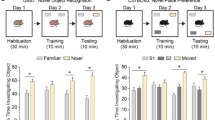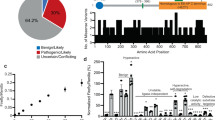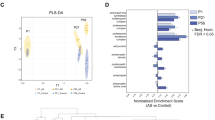Abstract
By using an in-house bacterial artificial chromosome-based X-tilling array, we detected a 0.4 Mb novel deletion at Xq24 that included UBE2A in a 4-year-old and 10-month-old boy with mental retardation and various other characteristics inherited from his mother; for example, marked developmental delay, synophrys, ocular hypertelorism, esotropia, low nasal bridge, marked generalized hirsutism and seizure. Although additional nine transcripts around UBE2A were also defective, a phenotypic similarity with a recently reported X-linked familial case involving a novel X-linked mental retardation syndrome and a nonsense mutation of UBE2A indicates a functional defect of UBE2A to be responsible for most of the abnormalities in these cases. Because some characteristics, such as congenital heart disease and proximal placement of the thumb, were not described in the family reported previously, suggesting genes other than UBE2A within the deleted region to be responsible for those abnormalities.
Similar content being viewed by others
Log in or create a free account to read this content
Gain free access to this article, as well as selected content from this journal and more on nature.com
or
References
Ropers, H. H. & Hamel, B. C. J. X-linked mental retardation. Nat. Rev. Genet. 6, 46–57 (2005).
Chiurazzi, P., Schwartz, C. E., Gecz, J. & Neri, G. XLMR genes: update 2007. Eur. J. Hum. Genet. 16, 422–434 (2008).
Tarpey, P. S., Smith, R., Pleasance, E., Whibley, A., Edkins, S., Hardy, C. et al. A systematic, large-scale resequencing screen of X-chromosome coding exons in mental retardation. Nat. Genet. 41, 535–543 (2009).
de Brouwer, A. P., Yntema, H. G., Kleefstra, T., Lugtenberg, D., Oudakker, A. R., de Vries, B. B. et al. Mutation frequencies of X-linked mental retardation genes in families from the EuroMRX consortium. Hum. Mutat. 28, 207–208 (2007).
Nascimento, R. M., Otto, P. A., de Brouwer, A. P. & Vianna-Morgante, A. M. UBE2A, which encodes a ubiquitin-conjugating enzyme, is mutated in a novel X-linked mental retardation syndrome. Am. J. Hum. Genet. 79, 549–555 (2006).
Honda, S., Hayashi, S., Kato, M., Niida, Y., Hayasaka, K., Okuyama, T. et al. Clinical and molecular cytogenetic characterization of two patients with non-mutational aberrations of the FMR2 gene. Am. J. Med. Genet. A 143A, 687–693 (2007).
Plenge, R. M., Stevenson, R. A., Lubs, H. A., Schwartz, C. E. & Willard, H. F. Skewed X-chromosome inactivation is a common feature of X-linked mental retardation disorders. Am. J. Hum. Genet. 71, 168–173 (2002).
Tai, H. C. & Schuman, E. M. Ubiquitin, the proteasome and protein degradation in neuronal function and dysfunction. Nat. Rev. Neurosci. 9, 826–838 (2008).
Acknowledgements
This work was supported by grants-in-aid for Scientific Research on Priority Areas and the Global Center of Excellence (GCOE) Program for International Research Center for Molecular Science in Tooth and Bone Diseases from the Ministry of Education, Culture, Sports, Science and Technology, Japan; and a grant from the New Energy and Industrial Technology Development Organization (NEDO); and in part by the research grant for Nervous and Mental Disorders from the Ministry of Health, Labour and Welfare, Japan. This work is part of an ongoing study by the Japanese Mental Retardation Research Consortium. We thank the patients and families for their generous participation in this study, S Watanabe and N Murakami for cell culture and EBV-transformation and M Kato, A Takahashi and R Mori for technical assistance. Shozo Honda is supported by Research Fellowship of the Japan Society for the Promotion of Science (JSPS) for Young Scientists.
Author information
Authors and Affiliations
Corresponding author
Additional information
Supplementary Information accompanies the paper on Journal of Human Genetics website
Supplementary information
Rights and permissions
About this article
Cite this article
Honda, S., Orii, K., Kobayashi, J. et al. Novel deletion at Xq24 including the UBE2A gene in a patient with X-linked mental retardation. J Hum Genet 55, 244–247 (2010). https://doi.org/10.1038/jhg.2010.14
Received:
Revised:
Accepted:
Published:
Issue date:
DOI: https://doi.org/10.1038/jhg.2010.14
Keywords
This article is cited by
-
Novel clinical and genetic insight into CXorf56-associated intellectual disability
European Journal of Human Genetics (2020)
-
Mechanistic insights revealed by a UBE2A mutation linked to intellectual disability
Nature Chemical Biology (2019)
-
A novel UBE2A mutation causes X-linked intellectual disability type Nascimento
Human Genome Variation (2017)
-
X-exome sequencing of 405 unresolved families identifies seven novel intellectual disability genes
Molecular Psychiatry (2016)
-
X-linked intellectual disability type Nascimento is a clinically distinct, probably underdiagnosed entity
Orphanet Journal of Rare Diseases (2013)



